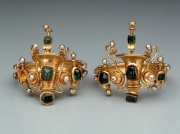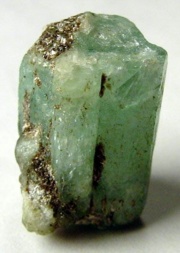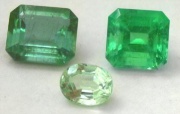Difference between revisions of "Emerald"
| Line 1: | Line 1: | ||
| − | [[File:1981.287-CR2875-d1.jpg|thumb|]] | + | [[File:1981.287-CR2875-d1.jpg|thumb|Bracelet with emeralds<br>MFA# 1981.288]] |
== Description == | == Description == | ||
| − | + | [[File:EmeraldroughWK.jpg|thumb|Uncut emerald]] | |
A transparent, green [[gemstone]] composed of beryllium aluminum silicate. The prismatic [[beryl]] crystals get their green color from trace amounts of [[chromium]] or [[vanadium]]. Emeralds were produced from Cleopatra's mines in Egypt's eastern desert in ancient times, but these stones were often flawed with microscopic elongated bubbles. Later, Romans made glass imitations of the stones because emeralds were ranked third in value after diamonds and pearls. High quality emeralds were imported from Columbia by the Spanish from the 1500s. The Muzo region, near Bogota, is still the main source for high quality emeralds. Other current sources for emeralds are the Urals, Austria (Habachtal), Norway, Australia, Tanzania, Zambia (discovered in 1931, produced since 1967), Zimbabwe (Sandawana, since 1956), Pakistan, India, Afghanistan, and Brazil. Emeralds tend to be brittle and crack easily. Since 1934, synthetic emeralds have been made from aquamarine seed crystals with a high-pressure, high-temperature process. They are used in lasers, masers, and semiconductors. | A transparent, green [[gemstone]] composed of beryllium aluminum silicate. The prismatic [[beryl]] crystals get their green color from trace amounts of [[chromium]] or [[vanadium]]. Emeralds were produced from Cleopatra's mines in Egypt's eastern desert in ancient times, but these stones were often flawed with microscopic elongated bubbles. Later, Romans made glass imitations of the stones because emeralds were ranked third in value after diamonds and pearls. High quality emeralds were imported from Columbia by the Spanish from the 1500s. The Muzo region, near Bogota, is still the main source for high quality emeralds. Other current sources for emeralds are the Urals, Austria (Habachtal), Norway, Australia, Tanzania, Zambia (discovered in 1931, produced since 1967), Zimbabwe (Sandawana, since 1956), Pakistan, India, Afghanistan, and Brazil. Emeralds tend to be brittle and crack easily. Since 1934, synthetic emeralds have been made from aquamarine seed crystals with a high-pressure, high-temperature process. They are used in lasers, masers, and semiconductors. | ||
| − | + | [[File:CutEmeraldsWK.jpg|thumb|Cut emeralds]] | |
| − | [[File: | ||
== Synonyms and Related Terms == | == Synonyms and Related Terms == | ||
| Line 10: | Line 9: | ||
green beryl; beryllium aluminum silicate; smaragd (Dan., Ned., Nor., Sven.); Smaragd (Deut.); esmeralda (Esp.); émeraude (Fr.); szmaragd (Pol.); esmeralda (Port.) | green beryl; beryllium aluminum silicate; smaragd (Dan., Ned., Nor., Sven.); Smaragd (Deut.); esmeralda (Esp.); émeraude (Fr.); szmaragd (Pol.); esmeralda (Port.) | ||
| − | == | + | ==Physical and Chemical Properties== |
| − | |||
| − | |||
| − | Fracture = uneven to conchoidal. Luster = vitreous. Streak = colorless. | + | * Hexagonal system with prismatic crystals usually striated lengthwise. |
| − | + | * Cleavage is poor in one direction. | |
| − | Natural stones may have inclusions. Synthetic emeralds appear opaque and dull red in UV light | + | * Weakly pleochroic. |
| + | * Fracture = uneven to conchoidal. | ||
| + | * Luster = vitreous. | ||
| + | * Streak = colorless. | ||
| + | * Natural stones may have inclusions. | ||
| + | * Synthetic emeralds appear opaque and dull red in UV light | ||
{| class="wikitable" | {| class="wikitable" | ||
| Line 27: | Line 29: | ||
|- | |- | ||
! scope="row"| Density | ! scope="row"| Density | ||
| − | | 2.68-2.78 | + | | 2.68-2.78 g/ml |
|- | |- | ||
! scope="row"| Refractive Index | ! scope="row"| Refractive Index | ||
| 1.57-1.60 | | 1.57-1.60 | ||
|} | |} | ||
| − | |||
| − | |||
| − | |||
| − | |||
| − | |||
== Comparisons == | == Comparisons == | ||
| Line 42: | Line 39: | ||
[[media:download_file_436.pdf|Properties of Common Gemstones]] | [[media:download_file_436.pdf|Properties of Common Gemstones]] | ||
| − | == | + | ==Resources and Citations== |
* Sue Fuller, ''Rocks and Minerals'', DK Publishing, Inc., New York City, 1995 | * Sue Fuller, ''Rocks and Minerals'', DK Publishing, Inc., New York City, 1995 | ||
Revision as of 16:21, 1 August 2022
Description
A transparent, green Gemstone composed of beryllium aluminum silicate. The prismatic Beryl crystals get their green color from trace amounts of Chromium or Vanadium. Emeralds were produced from Cleopatra's mines in Egypt's eastern desert in ancient times, but these stones were often flawed with microscopic elongated bubbles. Later, Romans made glass imitations of the stones because emeralds were ranked third in value after diamonds and pearls. High quality emeralds were imported from Columbia by the Spanish from the 1500s. The Muzo region, near Bogota, is still the main source for high quality emeralds. Other current sources for emeralds are the Urals, Austria (Habachtal), Norway, Australia, Tanzania, Zambia (discovered in 1931, produced since 1967), Zimbabwe (Sandawana, since 1956), Pakistan, India, Afghanistan, and Brazil. Emeralds tend to be brittle and crack easily. Since 1934, synthetic emeralds have been made from aquamarine seed crystals with a high-pressure, high-temperature process. They are used in lasers, masers, and semiconductors.
Synonyms and Related Terms
green beryl; beryllium aluminum silicate; smaragd (Dan., Ned., Nor., Sven.); Smaragd (Deut.); esmeralda (Esp.); émeraude (Fr.); szmaragd (Pol.); esmeralda (Port.)
Physical and Chemical Properties
- Hexagonal system with prismatic crystals usually striated lengthwise.
- Cleavage is poor in one direction.
- Weakly pleochroic.
- Fracture = uneven to conchoidal.
- Luster = vitreous.
- Streak = colorless.
- Natural stones may have inclusions.
- Synthetic emeralds appear opaque and dull red in UV light
| Composition | Be3Al2SiO6 |
|---|---|
| Mohs Hardness | 7.5 - 8 |
| Density | 2.68-2.78 g/ml |
| Refractive Index | 1.57-1.60 |
Comparisons
Properties of Common Gemstones
Resources and Citations
- Sue Fuller, Rocks and Minerals, DK Publishing, Inc., New York City, 1995
- Jack Odgen, Jewellery of the Ancient World, Rizzoli International Publications Inc., New York City, 1982
- A.Lucas, J.R.Harris, Ancient Egyptian Materials and Industries, Edward Arnold Publishers Ltd., London, 4th edition, 1962
- Yasukazu Suwa, Gemstones: Quality and Value, Volume 1, Sekai Bunka Publishing Inc., Tokyo, 1999 Comment: RI=1.577-1.583; Specific gravity=2.72
- Michael O'Donoghue and Louise Joyner, Identification of Gemstones, Butterworth-Heinemann, Oxford, 2003 Comment: Chivor emeralds:RI=1.571-1.574; 1.577-1.580; spec.grav.=2.67-2.71 Muzo emeralds:RI=1.576-1.580; 1.582-1.586; spec.grav.=2.71-2.72
- Wikipedia, the free encyclopedia, at http://www.wikipedia.com
- G.S.Brady, Materials Handbook, McGraw-Hill Book Co., New York, 1971
- Richard S. Lewis, Hawley's Condensed Chemical Dictionary, Van Nostrand Reinhold, New York, 10th ed., 1993
- Van Nostrand's Scientific Encyclopedia, Douglas M. Considine (ed.), Van Nostrand Reinhold, New York, 1976
- Random House, Webster's Encyclopedic Unabridged Dictionary of the English Language, Grammercy Book, New York, 1997


